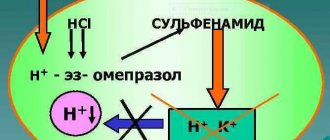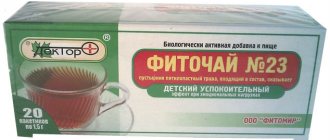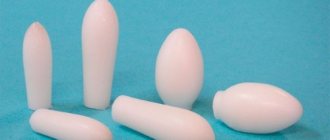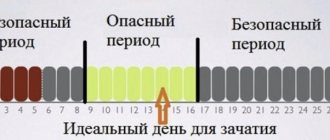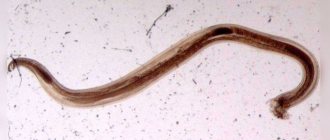Worms
(scientific name
helminths
) are worms that live inside humans. Worms are parasites, that is, organisms whose life activity is based on the exploitation of the host organism.
Helminths (worms) are the most common human parasites. According to research, every 4th person in the world is infected with worms. 70 species of worms have been registered in Russia. They all belong to three classes: roundworms, flatworms and flukes. The most common roundworms are roundworms, mainly pinworms, roundworms and whipworms.
There are also intestinal and extraintestinal helminths. Intestinal are those that live in the lumen of the human intestine, and extraintestinal (or tissue) are those living in muscle tissue or organs. Worms can affect the brain, lungs, liver, and lymphatic vessels.
Several types of helminths can parasitize one person at once, and this is a fairly common situation.
Infection of a person with worms is called helminthic infestation
.
helminthiasis
is also used .
Causes of helminthiasis
How does worm infection occur?
Adults inside humans lay a huge number of eggs (hundreds and thousands per day). Worm eggs are excreted from the human body along with feces. In order for a new host to become infected, it is necessary for the helminth eggs to enter his intestines. In most cases, this occurs along with food intake, for example, when eating with unwashed hands or when eating unwashed vegetables and fruits. Some types of helminthic infestations are geohelminthiases. In this case, the eggs of the parasite must first mature by being in the soil for some time (such as roundworms). Other types of worms are used for the maturation of intermediate “hosts” - animals. These are tapeworms - the most famous of the flat parasitic worms - bovine and pork. Their larvae mature in the muscles of animals and enter the human body along with meat that has not undergone proper heat treatment, and already inside a person they turn into an adult.
The opposite situation is also possible, when the human body is used by the helminth as an incubator for the larvae. The final host of such parasites is a predator. The predator is expected to catch the prey and eat the meat infected with the larvae. In this regard, a person is a dead end - a larva that gets into it will no longer turn into an adult, but the larvae
predator worms can cause us a lot of harm. In the human environment, two typical predatory animals are a dog and a cat. They can become a source of infection. The eggs of worms from these animals enter the human intestine, where they hatch into larvae, which can then migrate throughout the body. The liver is most often affected. To prevent infection from pets, you should not kiss them, and a dog that can become infected with helminths while running along the street must be subjected to regular treatment for worms.
Also, worm eggs can enter our body through inhalation of dust or with a sip of water when swimming in a pond. Flies carry worm eggs.
Drug prevention of parasitosis
With enterobiasis, you cannot trust a single smear test - it is often false negative, and the transmission of parasite eggs occurs very easily. Children attending kindergarten and school are highly infected with enterobiasis, and therefore the risk of illness for the whole family is high.
It is not advisable to constantly take pills, because infection can happen at any time, and the harm from medications is not small. Much more important is daily hygiene - changing linen, frequent hand washing. Many experts advise, for preventive purposes, to eat pumpkin seeds and drink dietary supplements against worms, the harm from which is minimal.
But if one of the family members is reliably infected, it is recommended to carry out prophylaxis for all other household members with the help of medications:
- Pyrantel;
- Vermox;
- Vormin.
Such drugs can be used once every six months without harm to health, at least until the child learns to strictly observe hygiene. It is important to treat worms and pets that can be a source of infection.
Worms in children
Children become infected with worms more often than adults. Small children tend to put everything in their mouth. While walking, children play on the ground and in the sandbox. They can hug and kiss strangers and stray animals. They don't care about dirty hands.
Therefore, it is so important to try to instill hygiene skills in children as early as possible. Young children should be supervised during walks, always having water and disinfectants ready to wash their hands and wipe their faces in time. And at the first signs of helminthic infestation, you should consult a doctor.
In Moscow, the most frequently detected helminth infections are enterobiasis and ascariasis.
Artlife Artemizin-M
Bioactive agent, supplement based on plant extracts. A safe drug, neutral for the liver, but with a good effect against worms and protozoal infections. The tablets contain extracts of St. John's wort, centaury, mint, tansy and other components.
Advantages of the drug:
- complex effect without a strong blow to the liver;
- neutralization of individuals at all stages of development;
- quick effect.
Disadvantages of Artlife Artemisin-M are a high risk of allergic reactions, prohibition on use during pregnancy and lactation. The drug has a fairly high daily dose (six tablets), and taking it is not very convenient. In case of large-scale infection and the need for long-term prophylaxis, it may be ineffective.
Enterobiasis – helminthiasis caused by pinworms
Pinworms are detected more often than other helminths (in 90% of cases of detection of worm infection).
Pinworms are grayish-white roundworms ranging from 2 to 12 mm in length. They parasitize the intestines. Females descend along the rectum, emerge from the anus and lay eggs in its circumference, after which they die. In this case, the patient feels severe itching in the anus. When scratching, pinworm eggs get on the skin of the hands and under the nails. Thus, if hygiene rules are not followed, constant self-infection is possible.
Pinworms have a short lifespan - 3-4 weeks. Theoretically, in order to be cured, hygiene procedures are enough - daily washing, keeping your hands clean, regularly changing your underwear and bed linen. And in a month the pinworms should disappear. However, since they primarily infect children, it is often impossible to ensure the necessary level of hygiene. Therefore, if you suspect enterobiasis, you should consult a doctor.
The main symptom of enterobiasis is itching in the anal area.
More about enterobiasis>>>
Nemozol
Chewable tablets with a wide range of effects. The species to be eliminated are tapeworms, roundworms, trematodes. Ascariasis and hookworm disease are treated with a single dose of the drug. The medicine is produced in India, is inexpensive, and can be taken from the age of six. The duration of the course is determined by the doctor - usually from 3 to 30 days. It is advisable to take it after meals; you can supplement it with other medicinal complexes.
"Nemozol" is quite effective due to the increased concentration of the active ingredient - it contains 400 mg of albendazole per tablet. To avoid relapse, a repeat course is recommended. Despite the advantages, you should approach taking the medicine with caution, because:
- This is a potent drug that is sold by prescription;
- for liver diseases, the drug is contraindicated during breastfeeding;
- If you calculate the dose incorrectly (and this is not easy), drug poisoning is possible.
Ascariasis - helminthiasis caused by roundworms
Ascariasis is diagnosed in 70% of cases of helminth infection.
Ascaris is a round worm, the length of which reaches 25 cm in males and 40 cm in females. Ascaris eggs must mature in the ground. Ripe eggs enter the human body when eaten with dirty hands or from unwashed vegetables and fruits. A larva hatches from an egg in the human intestine, but, unlike an adult, it requires air. Therefore, the larva, which at this moment has a microscopic size, penetrates the blood vessels and migrates throughout the body, reaching the lungs. In the lungs, the larvae grow and mature, moving through the alveoli into the bronchi, and from the bronchi into the trachea. The human body reacts to the helminth by coughing (this is a specific symptom of ascariasis). The larvae are expectorated along with sputum and are accidentally ingested by humans. This allows the already developed larva to enter the intestine again, where the adult continues to exist. The entire migration process takes about 2 weeks.
Roundworms can live in the human body for up to a year, in some cases longer. During this period, the waste products of the roundworm poison the body of the “host”, causing disturbances in the functioning of the digestive, nervous and reproductive systems.
Helmindazole
A drug with a variety of indications, the most effective for nematodes, pinworms, roundworms and cestodes. The main component is the same as in the previous drug - mebendazole. Its 10%, the rest is occupied by auxiliary ingredients - starch, magnesium stearate. They contain lactose, and it is better for a person with lactose intolerance to avoid them.
Among the advantages of the drug are ease of administration, good digestibility, and the rarity of allergic reactions. In patients with diabetes, the tablets reduce the need for insulin, but when taking the drug you need to very carefully monitor glucose levels and monitor the condition of the liver and kidneys. The drug has a strong effect on them. Other cons:
- prohibition of use together with lipophilic components;
- drowsiness (cannot be taken while driving), possible coloration of the whites of the eyes in a yellowish tint;
- contraindications - intestinal diseases, lactation period and others.
Symptoms of helminthiases
The body tries to resist the penetration of worms. The first consequences of helminth infestation are precisely related to the body’s immune response to the ingress of helminth eggs and larvae. This acute stage lasts (depending on the type of parasite) from several weeks to several months. An allergic reaction can be expressed in the form of a rash, swelling, swollen lymph nodes, cough, etc.
If all the body’s protective barriers are broken, then helminthiasis enters the chronic stage.
The larva develops into an adult. In the case of single parasites, a person may not notice their presence, but if there are many helminths, then the consequences of their presence inside the body significantly affect health.
Worms damage tissues by attaching to them using their fixation organs (hooks, spines, etc.), as a result of which inflammation can develop in this place.
Worms create a comfortable environment for themselves. In particular, they cause suppression of the immune system so that the body's defense system no longer reacts to their presence. Reduced immunity causes a person to become susceptible to various infectious diseases.
The presence of worms in the human intestines disrupts metabolism, as the worms absorb nutrients (proteins, minerals, vitamins, carbohydrates). Some varieties of worms secrete substances that neutralize the digestive enzymes of the host. The waste products of worms cause changes in the intestinal microflora, promoting the development of pathogenic microorganisms.
Many types of worms are hemophages, that is, they feed on the host’s blood, contributing to the development of anemia and vitamin deficiency (worms absorb the much-needed vitamin B12).
If the parasite lives not in the intestines, but in the tissues of some organ, then its growth causes compression and deformation of the tissues, which can lead to disruption of the functions of this organ (brain, liver, eyeball).
Suspicion of helminthiasis, first of all, causes disruption of the digestive system and neurological disorders.
Gastrointestinal manifestations of helminthic infestation
The consequences of the presence of worms in the body are not specific and can be mistaken for symptoms of various diseases. A person may complain of occasional pain in the abdominal area of unclear localization, flatulence, or a feeling of fullness in the abdomen. Appetite may increase or be completely absent. Bowel disturbances (constipation or diarrhea) may occur.
Neurological manifestations of helminthic infestation
Helminthic infestation is often the cause of neuropsychiatric disorders - this is the result of the presence in the blood of toxins produced by helminths. The patient may feel general weakness, emotional instability, fatigue, and loss of concentration may be observed.
What to look for when buying deworming medicine
Types of tablets
On sale are both narrowly targeted drugs that affect one group of parasites, and drugs with a broad spectrum of action.
Basically, tablets are selected based on test results, which clearly indicate the type of helminths that caused the disease. Depending on the direction of action, drugs are divided into the following groups:
- for the treatment of nematodes - levamisole, pyrantel pamoate, pyrvinium embonate, carbendacim, diethylcarbimazine;
- for the treatment of trematodes - hloksil;
- for the treatment of cestodiasis - niclosamide;
- with an extended spectrum of activity - mebendazole, albendazole, praziquantel.
Medicines from the mebendazole group are considered the most modern and effective, so they are prescribed most often.
When choosing drugs, you should remember that there are no completely safe anthelmintic drugs. They must have a strong effect in order to destroy worms, so adverse reactions often occur when taken.
Manufacturer
The products of the following pharmaceutical companies are very popular:
- Gedeon Richter (Hungary). A transnational company that has been producing medicines since 1901. It is the largest corporation in Central and Eastern Europe, with representative offices in 40 countries.
- IPCA LABORATORIES (India). A large corporation that has quality certificates from the American FDA and the English MHRA. The company supplies products to 36 countries.
- Polpharma (Poland). The pharmaceutical plant was established in 1935. The company produces drugs for gastroenterology, neurology and cardiology.
- CADILA PHARMACEUTICALS (India). A large corporation that produces medicines and food supplements. The Indian company's drugs are approved by WHO, GMP, MHRA.
Methods for diagnosing helminthiasis
Since the symptoms of helminthiasis coincide with the signs of many other diseases, before prescribing treatment, it is necessary to make sure that worms are actually present in the body. For this purpose, various laboratory diagnostic methods are used.
Analysis of stool for worm eggs
If a helminthic infestation is suspected, the first step is to perform a stool test for worm eggs. To be more confident in the absence of worms, it is recommended to do such an analysis several times (a negative result in the case of a single analysis does not guarantee that there are no worms). However, enterobiasis cannot be detected using stool analysis.
More information about the diagnostic method
Scraping for enterobiasis
Scraping for enterobiasis allows you to identify pinworm infection.
Serological blood test
In difficult situations, additional tests are possible, in particular, a serological blood test for the presence of antigens and antibodies to a particular type of parasite.
More information about the diagnostic method
Sign up for diagnostics To accurately diagnose the disease, make an appointment with specialists from the Family Doctor network.
Piperazine
Well-known anthelmintic tablets with proven anthelmintic effectiveness. This is an inexpensive drug with a wide coverage of parasites, whose deworming rate reaches up to 95%. It copes best with roundworms and pinworms. Advantages of tablets:
- short course - single or double dose;
- can be taken with or after meals;
- different dosage options - 200 and 500 mg of piperazine adipenate.
In order for Piperazine to have an effect against parasites, doctors recommend evening enemas between courses. It should not be given to children under three to six years of age; the dosage must be carefully selected after analyzing the patient’s condition. Other disadvantages of the drug are strict requirements for personal hygiene between courses of use, and the need to take tablets at least two or three times to achieve the effect.
Methods for treating helminthiases
Despite the fact that helminthiasis is a common occurrence, it cannot be treated as something normal.
Worm infestation is a serious problem for the body, in some cases it can even lead to death. Worms cannot be tolerated. Infection with worms must be prevented, and if it occurs, the worms must be removed. To treat helminthiases, courses of special medications are prescribed.
If you suspect a worm infection, you should consult a therapist, and if you are talking about a child, a pediatrician or family doctor. In some cases, the doctor may recommend that the whole family take anthelmintic medications.
Pediatricians, family doctors and therapists at Family Doctor have extensive experience in identifying and treating various helminthiases. It is worth remembering that getting rid of parasites is a serious increase in our health!
Deworming
The procedure for removing worms from the body is called deworming
.
Along with anthelmintic drugs, the course of treatment usually includes drugs that help remove and bind toxic substances produced by worms, as well as antiallergic drugs.
Make an appointment Do not self-medicate. Contact our specialists who will correctly diagnose and prescribe treatment.
Rate how useful the material was
thank you for rating
Clinical cases
Patient K., 35 years old, complained of frequent painful urination that appeared after the summer holidays. At the end of urination, blood was sometimes released. The duration of the disease is 1.5 months. She was treated with antibiotics and other drugs with a diagnosis of cystitis. The treatment brought temporary relief, and then the complaints intensified again. According to ART diagnostics, schistosoma haematobium (schistosoma) was identified. After a course of BRT therapy and homeopathic medicine for two weeks, my health improved significantly. At a follow-up examination after 1 month, schistosoma is not tested.
A 6-year-old child was referred due to a herpes rash on the face. ART testing revealed ascariasis. After homeopathic treatment, BRT therapy, herbal medicine, ascariasis is not tested. Herpes did not recur.
Patient B., 45 years old, applied due to an existing polyvalent allergy to foods, medications, and household allergens, which manifested itself in urticaria and angioedema. Due to illness, she left her job. An examination using the ART method revealed: toxoplasmosis, ascariasis, fascioliasis. After a course of treatment for a year, my health improved significantly, I learned a new specialty, and got a job.
Types of helminths
The common name helminths includes several groups of worms belonging to different species:
- nematodes - roundworms, which include pinworms, hookworms, roundworms, worms, trichinella and many others, having a cylindrical body shape in cross-section, represent the most numerous type of helminths;
- cestodes - flat-shaped tapeworms: echinococcus, pork, bovine tapeworm, wide tapeworm, these parasites can reach large sizes and cause deadly damage to internal organs;
- trematodes - leaf-shaped worms: various types of flukes, flukes, localized inside the tissues of organs.


